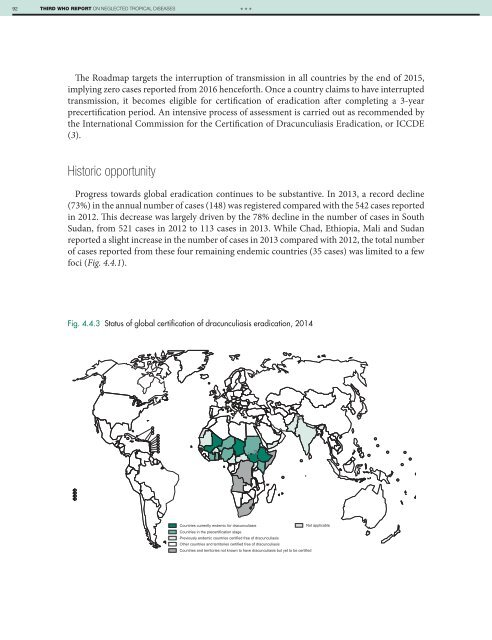1A9bnbK
1A9bnbK
1A9bnbK
You also want an ePaper? Increase the reach of your titles
YUMPU automatically turns print PDFs into web optimized ePapers that Google loves.
92 THIRD WHO REPORT ON NEGLECTED TROPICAL DISEASES<br />
***<br />
The Roadmap targets the interruption of transmission in all countries by the end of 2015,<br />
implying zero cases reported from 2016 henceforth. Once a country claims to have interrupted<br />
transmission, it becomes eligible for certification of eradication after completing a 3-year<br />
precertification period. An intensive process of assessment is carried out as recommended by<br />
the International Commission for the Certification of Dracunculiasis Eradication, or ICCDE<br />
(3).<br />
Historic opportunity<br />
Progress towards global eradication continues to be substantive. In 2013, a record decline<br />
(73%) in the annual number of cases (148) was registered compared with the 542 cases reported<br />
in 2012. This decrease was largely driven by the 78% decline in the number of cases in South<br />
Sudan, from 521 cases in 2012 to 113 cases in 2013. While Chad, Ethiopia, Mali and Sudan<br />
reported a slight increase in the number of cases in 2013 compared with 2012, the total number<br />
of cases reported from these four remaining endemic countries (35 cases) was limited to a few<br />
foci (Fig. 4.4.1).<br />
Fig. 4.4.3 Status of global certification of dracunculiasis eradication, 2014<br />
Countries currently endemic for dracunculiasis<br />
Not applicable<br />
Countries in the precertification stage<br />
Previously endemic countries certified free of dracunculiasis<br />
Other countries and territories certified free of dracunculiasis<br />
Countries and territories not known to have dracunculiasis but yet to be certified


